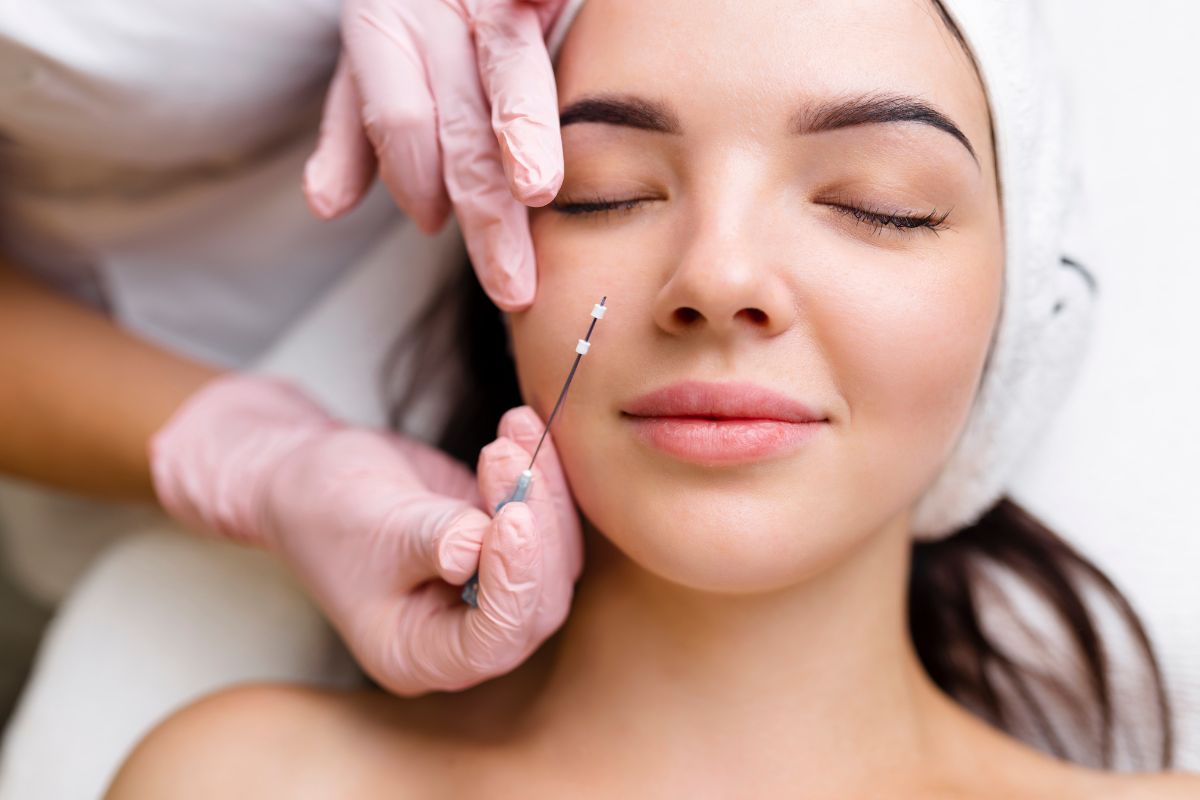About Threads
Threads can improve skin elasticity, promote collagen production, and contour the face. It is a minimally invasive procedure that can treat fine lines and wrinkles, skin laxity, and sagging facial tissues to give a more youthful appearance.
Aging causes volume loss in the deeper fat compartments of the face which reduces the support for the overlying skin and fat. This loss of support causes downward movement ultimately resulting in jowl formation and sagging of tissues around the mouth and nose.
Thread lifting (also known as suture suspension) is a quick, safe, minimally invasive procedure for patients who are not ready to undergo a surgical face lift.
Dr. Fisher has undergone extensive training in both Canada and Korea to learn the most up to date, safe and effective techniques for doing thread treatments.
Threads are made of polydioxanone (PDO), polycaprolactone (PCL) and poly-L-lactic acid (PLLA). These products have been used safely for absorbable sutures for many years. They are placed under the skin to stimulate collagen production while slowly breaking down over time. Dr. Fisher uses both PDO and PCL threads in her practice.
There are two types of threads that are commonly used. Mechanical lifting threads and smooth threads. Mechanical lifting threads can be used to lift the skin back to its natural position. Smooth threads are used to smooth and tighten the skin. Mechanical threads also cause smoothing and tightening of skin due to their collagen stimulating abilities.
The ideal candidate is 30-60 years of age with mild to moderate wrinkle formation, eyebrow descent, deepening of nasal folds, early jowl formation, and visible marionette lines with sufficient fat and flexible skin on the area to be treated.
Patients with excessively thin skin may experience visibility of the threads or bunching and dimpling of the skin after insertion. Patients with excessively thick skin or heavy tissues may not see a noticeable lift.
If there is severe laxity of the skin, you should not get threads or there will be bunching and dimpling to achieve a significant lift. If you have had recent facial surgery in the area to be treated, you should postpone thread treatment until at least 4-6 months post-surgery.
Patients with a compromised immune system, underlying skin infections and implants in the areas to be treated are not good candidates for threads. Threads cannot be performed on women who are pregnant of breastfeeding.
Threads are inserted under the skin. Lifting threads have molded edges (called barbs) which anchor to the soft tissue. When the thread is pulled tension is created on the skin to lift the loose soft tissue and reshape and contour the area being treated. In addition, as threads are slowly broken down by the body collagen and elastin is produced allowing the tension to continue to suspend the tissue after the thread has disappeared.
Nasolabial folds, marionette lines, neck, jowls, brow lift, breasts, and knees. Basically, anywhere where this is mild to moderate laxity of the skin.
Lines and wrinkles on the face and neck, nasolabial folds, marionette lines, jowls, nose straightening, upper lip lines, under eye bags, lip border enhancement, double chin and crepey skin on the arms and legs.
Lifting threads have an immediate effect which improves over the next 3 months as the threads stimulate collagen. Smooth threads can have some immediate effects, but the full results are not visible for 3 months.
Thread lifting is not permanent. Results generally last 1 year or more and maintenance treatments are recommended for continued results. As threads stimulate collagen there is improvement in skin quality which lasts up to 18 months.
Thread lift using threads made of PCL last longer than PDO threads as it takes longer for the body to breakdown PCL threads.
There is minimal pain with insertion of threads. Topical and injectable freezing are used to make the procedure as comfortable as possible.
Thread lifting is a safe procedure when using the correct technique and placement of threads. An in-depth understanding of anatomy, thread characteristics, as well as correct patient selection are important to prevent unwanted side effects.
Patients usually experience localized pain, bruising and swelling. These may last a few days. There may be some mild impairment in eating and speaking when threads are done around the mouth. This resolves in 3-4 days.
There may be thread visibility or dimpling of skin which generally resolves without treatment. Rarely there may be thread breakage, infection, nerve, or muscle damage which can be avoided with proper placement and following all post care instructions.
Thread lifting can cause nerve damage, but this is rare with proper placement of threads. Seeing an experienced injector with a good understanding of anatomy will minimize this risk.
It is recommended that you do not take any non-essential blood thinning medications (ASA, aspirin, ibuprofen), supplements (fish oil, Vitamin E) or herbal remedies (garlic, ginkgo, dong quai, ginger, turmeric) for 1 week before thread treatment. If you are required to be on any blood thinners for medical reasons you should continue them, but you will be at an increased risk of bruising.
Alcohol should be avoided for 48 hours before treatment to reduce the chance of bruising.
Come to the appointment with a clean face with no make-up.
Avoid high impact exercise and excessive heat (hot tubs, saunas) for 48 hours to minimize swelling and bruising. You may use cold compresses, take arnica, or use Vitamin K cream to if you experience swelling and bruising. Avoid massaging or rubbing the area or sleeping face down for 1 week. Makeup may be used on the area after ti4 hours. You should not undergo any dental procedures for at least 4 weeks after treatment. You should avoid facials or facial massages for 3-4 weeks. Alcohol may affect healing and exacerbate swelling and bruising so should be avoided for 48 hours after treatment.
